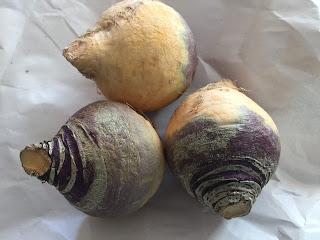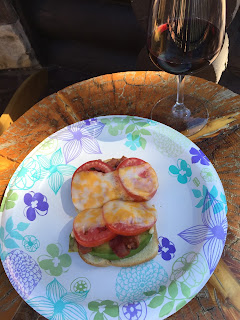 |
| Ugli (or Uniq) Fruit as seen in your local market. |
Uu, Uuu. Uuuuu. I can’t write the letter Uu without thinking
about that exchange between Robert De Niro and Billy Crystal in the movie Analyze This. So funny.
If any of you were standing in
front of me right now, I too would likely be saying “you, you, youuu,” smiling
with an expression of knowing, as I simultaneously moved my pointed finger back
and forth.
It is because of you
I write this Blog. I so appreciate all
the comments, questions and input I have received from so many of you.
My school chums Andrea and David L. who I can always count on to add a
note of interest and enthusiasm to my Blogs.
And David, you, Sandra (of Sandi’s Cobbler Cups) and her husband Vince
with your penchants for gardening only serve to further motivate me in seeking
out unique and wonderful produce from Catus Leaves to Fiddleheads. You,
Mary M. who expressed gratitude on my timely Rutabaga Blog, as you sought out
recipes for a rather special Thanksgiving side dish. Megan, Cheryl, Lenore and Mr. Williams, you, my DWSS comrades, can’t know how
much your chiming in brings a smile to my face and warms my heart. Love being part of your newsletter Mr.
Williams! My Golden Girls, it is you I can consistently count on to write
notes of support and encouragement as you did in response to “Bringing Them
Home,” and “Qq Is For Quince.” Certainly
a shout out goes to my family members.
My niece Megan, my sister Janice and my Aunt Rose who acknowledged “A
Date With Nana,” and “Another Lap Around The Sun.” Can’t do this kind of thing without family in
my corner. And of course my Friends Amid
Food, remembrances of our supper club gatherings, dishes we prepared and ate
together, you all serve as mire poix
foundations for me as I write this bi-weekly Blog. Which I have to be honest, has not always
been published on a bi-weekly basis. And
explains why, here it is the last day of 2015 and I am only on letter Uu.
Now, I’m betting you’re wondering just what seasonal food I
would be able to Blog about that is one; currently in season and two; begins
with the letter Uu. Well wonder no more,
I’ve had this up my sleeve for a while now and lucky for me this is the early part
of the season for Ugli Fruit. Also known as Uniq Fruit.
You may have only briefly seen these gnarly looking tropical
orbs, which are native to Jamaica, in your local grocery store as they are in
season for about five short months, December to April. Though so unattractive as citrus, you
probably kept on walking by without even inquiring about it to your produce
guy. The Ugli Fruit is a naturally hybridized combination of an orange and
grapefruit, likely with some input from the pomelo (the original
grapefruit). A thick, pock-marked,
greenish-yellowish-orange rind fits loosely, like the wrinkly skin on the knees
and ankles of elephants, encasing a pale orange-yellow pulp. A bit sweeter than grapefruit and dripping
with juice Ugli Fruit is consistent
with its other citrus relatives in that it is high in vitamin C and has a fair
amount of fiber. Another plus, there are
hardly, if any, seeds inside.
When choosing Ugli
Fruit look for those that feel heavy for their size and are somewhat soft
but not mushy. The smaller ones are
sweetest. They keep for up to five days
in your fruit basket or two weeks in the fridge. I eat Ugli
Fruit the same way I eat an orange,
however I do take the time to supreme the
sections. Not supreme but supreme.
This is the process of removing all the white membrane, which is edible
but gives that bitter after-taste to oranges and other citrus. Use a sharp paring or small slicing knife so
you can easily cut between each segment of the fruit.
 |
| I'm using a combination of Ugli Fruit, Grapefruit and Oranges today. |
To supreme simply:
1 Trim top and bottom off the fruit and
discard. Remove the peel by slicing lengthwise between flesh and peel,
following fruit's contour and toss peel into trash.
2 Hold the fruit in the palm
of one hand over a bowl to catch juices. Slice lengthwise between 1 segment and
the membrane until you reach the center of the fruit.
3 Make
a similar slice on the other side of the same segment. Use the knife blade to
remove segment. Repeat this process for each segment until you have a nice
little arrangement of wedges on your cutting board.
4 Once
all segments are removed, squeeze any remaining juices from membrane into the
bowl. You will end up with the skeleton of the citrus fruit membrane. Discard membrane and reserve the juice for
another use.
 |
| I squeezed the juice from the Ugli with my hand here. |
 |
| For the grapefruit and orange I used my old hand juicer. |
Once you’ve separated your sections of the Ugli Fruit you can indulge and eat it
as it, or add the wedges to your salad in place of mandarin oranges. Lamb lettuce or grilled endive that has been
sliced and mixed with arugula or radicchio a few sliced strawberries or
blueberries and slivered almonds all drizzled with a light vinaigrette will
make for an enticing and different tasty salad.
But I’m still too
cold to munch on salads these days, instead I’m using my Ugli Fruit to prepare a warmed concoction of dark rum (my homage to
Jamaica) simple syrup and freshly squeezed Ugli
Fruit juice.
 |
| Warm it up - It is afterall a hot tottie |
4 ounces freshly squeezed Ugli Fruit juice, 4 ounces simple syrup, 2 ounces water, 2 ounces dark rum.
Add all ingredients to a saucepot and warm over medium heat to desired temperature. Pour into two glasses or mugs and garnish with a wedge of Ugli Fruit or Orange and a cinnamon stick.
Serves 2
 |
| I'd add a cinnamon stick - but ran out over the holidays |
 |
| For the purest in the group |
As we bring 2015 to a close, I just want to thank all of Uu for your comments, suggestions and
questions. Keep them coming. As for the remains of today I’m going to ring
in the New Year with my Ugli-Rum hot
tottie while these black-eyed peas finish soaking.
 |
| Gotta start the New Year out right! |











































